
Call of Cthulhu is a horror fiction role-playing game based on H. P. Lovecraft's story of the same name and the associated Cthulhu Mythos. The game, often abbreviated as CoC, is published by Chaosium; it was first released in 1981 and is in its seventh edition, with licensed foreign language editions available as well. Its game system is based on Chaosium's Basic Role-Playing (BRP) with additions for the horror genre. These include special rules for sanity and luck.

The Generic Universal RolePlaying System, or GURPS, is a tabletop role-playing game system designed to allow for play in any game setting. It was created by Steve Jackson Games and first published in 1986 at a time when most such systems were story- or genre-specific.
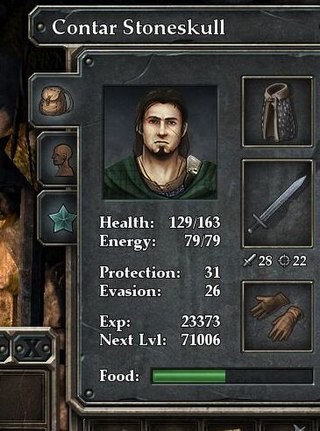
An experience point is a unit of measurement used in some tabletop role-playing games (RPGs) and role-playing video games to quantify a player character's life experience and progression through the game. Experience points are generally awarded for the completion of missions, overcoming obstacles and opponents, and successful role-playing.

Delta Green is a contemporary era setting for the Call of Cthulhu role-playing game created by Adam Scott Glancy, Dennis Detwiller, and John Scott Tynes, a.k.a. the Delta Green Partnership, of the Seattle gaming house Pagan Publishing. The setting first appeared in a 1992 RPG scenario and revolves around a secretive organization tasked with protecting the United States from paranormal and alien threats. Delta Green combines the classic 1920s Cthulhu Mythos of H.P. Lovecraft with modern conspiracy fiction.

d20 Modern is a modern fantasy role-playing game system designed by Bill Slavicsek, Jeff Grubb, Rich Redman, and Charles Ryan. The system's core rulebook was published by Wizards of the Coast on November 1, 2002; by 2006, ten additional supplements were released. The game is based on the d20 System and the Dungeons & Dragons 3rd Edition ruleset. It includes various campaign settings along with the tools to build campaigns in modern/contemporary settings.

HeroQuest is a role-playing game written by Robin D. Laws first published as Hero Wars by Issaries, Inc. in 2000. It has its roots in Greg Stafford's fantasy world of Glorantha, but was designed as a generic system, suitable for, but not tied to any particular genre.

Robin D. Laws is a Canadian writer and game designer who lives in Toronto, Canada. He is the author of a number of novels and role-playing games as well as an anthologist.

Kenneth Hite is a writer and role-playing game designer. Hite is the author of Trail of Cthulhu and Night's Black Agents role-playing games, and lead designer of the 5th edition of Vampire: the Masquerade.

Conspiracy X is a role-playing game (RPG) originally released by New Millennium Entertainment in 1996, and since revised and released by several publishers including Steve Jackson Games and Eden Studios, Inc. In all versions, the setting posits that aliens are insiduously taking over the world, reminiscent of The X-Files.
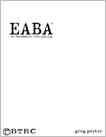
The End All Be All game system, commonly known as EABA and pronounced "ee-buh", is a role-playing game system from Blacksburg Tactical Research Center (BTRC). It is a generic gaming system designed to adapt to any imaginary gaming environment. It was created by Greg Porter in 2003. The game cites the Hero System, GURPS and Call of Cthulhu as influences in its development.

Pelgrane Press Ltd is a British role-playing game publishing company based in London and founded in 1999. It is co-owned by Simon J Rogers and Cat Tobin. It currently produces GUMSHOE System RPGs, 13th Age, the Diana Jones award-winning Hillfolk RPG, The Dying Earth Roleplaying Game, and other related products. It publishes fiction under the Stone Skin Press imprint.
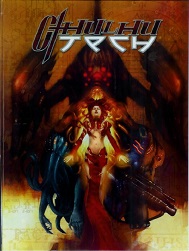
CthulhuTech is a science-fiction and horror roleplaying game created by Wildfire LLC and published by Sandstorm that combines elements of the Cthulhu Mythos with anime-style mecha, horror, magic and futuristic action. The setting is Earth in 2085 during a worldwide conflict known as the Aeon War, wherein the planet has been invaded twice: once by a black-skinned manufactured alien race known as the Nazzadi who are derived from humans and who join forces with them, and then a second time by the Mi-Go, an advanced alien civilization seemingly bent on the enslavement of humanity. Aside from these conflicts, the game focuses on other factions, such as ancient cults like the Esoteric Order of Dagon that are running amok across the planet and the eldritch horrors that are rising to destroy the world as, according to the prophecies of the Cthulhu Mythos, the "stars are right" and the Great Old Ones and their servitors are returning/reawakening to reclaim the Earth. The game uses a proprietary ten-sided die (d10) system titled "Framewerk."

Trail of Cthulhu is an investigative horror role-playing game published by Pelgrane Press in 2008 in which the players' characters investigate mysterious events related to the Cthulhu Mythos. The game is a licensed product based on the horror role playing game Call of Cthulhu published by Chaosium, which is itself based on the writings of H. P. Lovecraft.
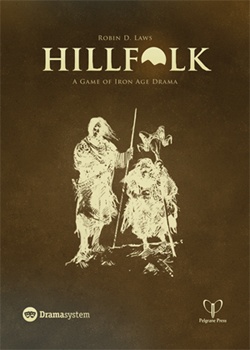
Hillfolk is a tabletop role-playing game designed by Robin Laws and published by Pelgrane Press. It was initially launched via Kickstarter in 2012, with the funding being sufficiently successful that a second book called "Blood on the Snow", containing 33 new settings, was produced as a part of the kickstarter. Reception was positive, with RPGamer saying "mechanics don't so much get out of the way of roleplay as provide a supportive foundation for it to happen." Hillfolk is influenced by the Indie RPGs of the 2000s, and emphasises relationships and interpersonal conflicts among the player characters, rather than what the system calls "procedural" scenes putting the characters against external obstacles.
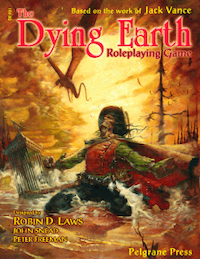
The Dying Earth Roleplaying Game is a tabletop role-playing game published by Pelgrane Press in 2001.

The Esoterrorists is a Contemporary Occult tabletop role-playing game, written by Robin D. Laws, and published by Pelgrane Press in 2006.
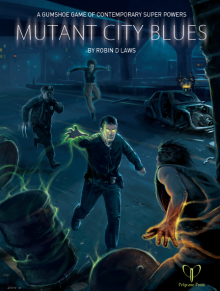
Mutant City Blues is a role-playing game published by Pelgrane Press in 2009.

Ashen Stars is a gritty space opera role-playing game published by Pelgrane Press in 2011.

Night's Black Agents is a role-playing game created by Kenneth Hite and published by Pelgrane Press in 2012.



















